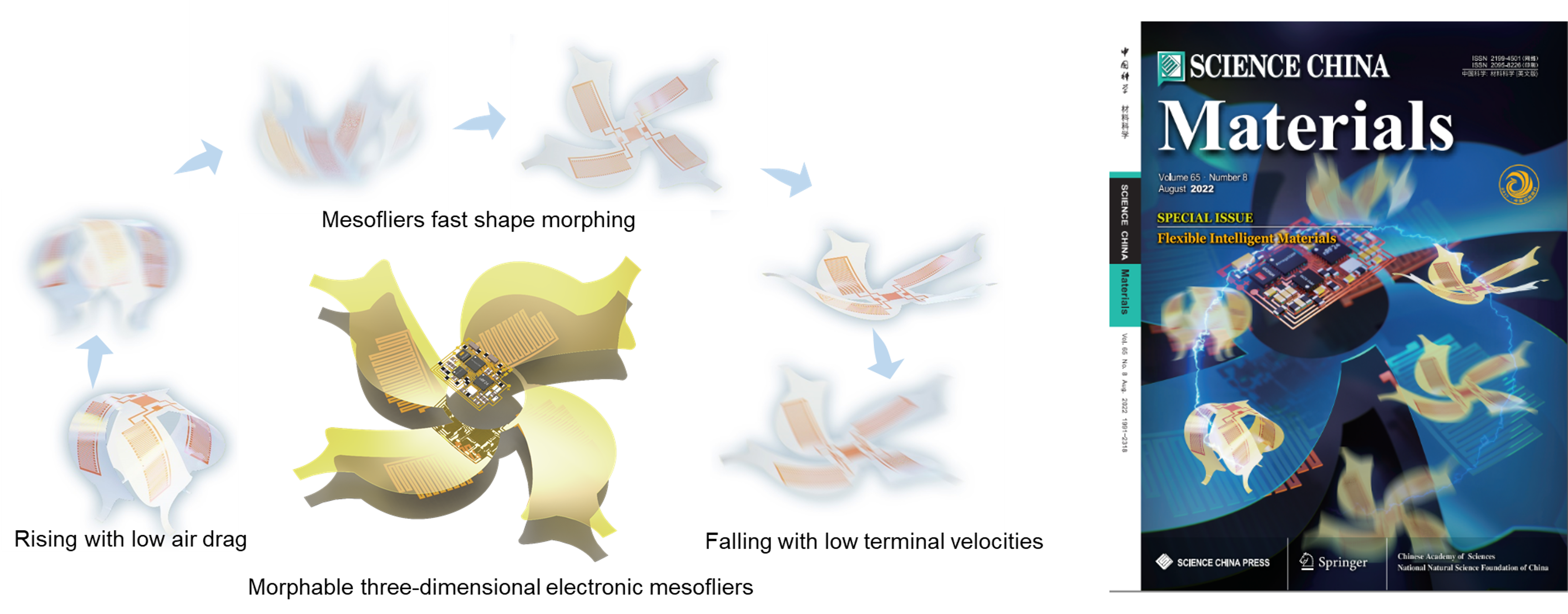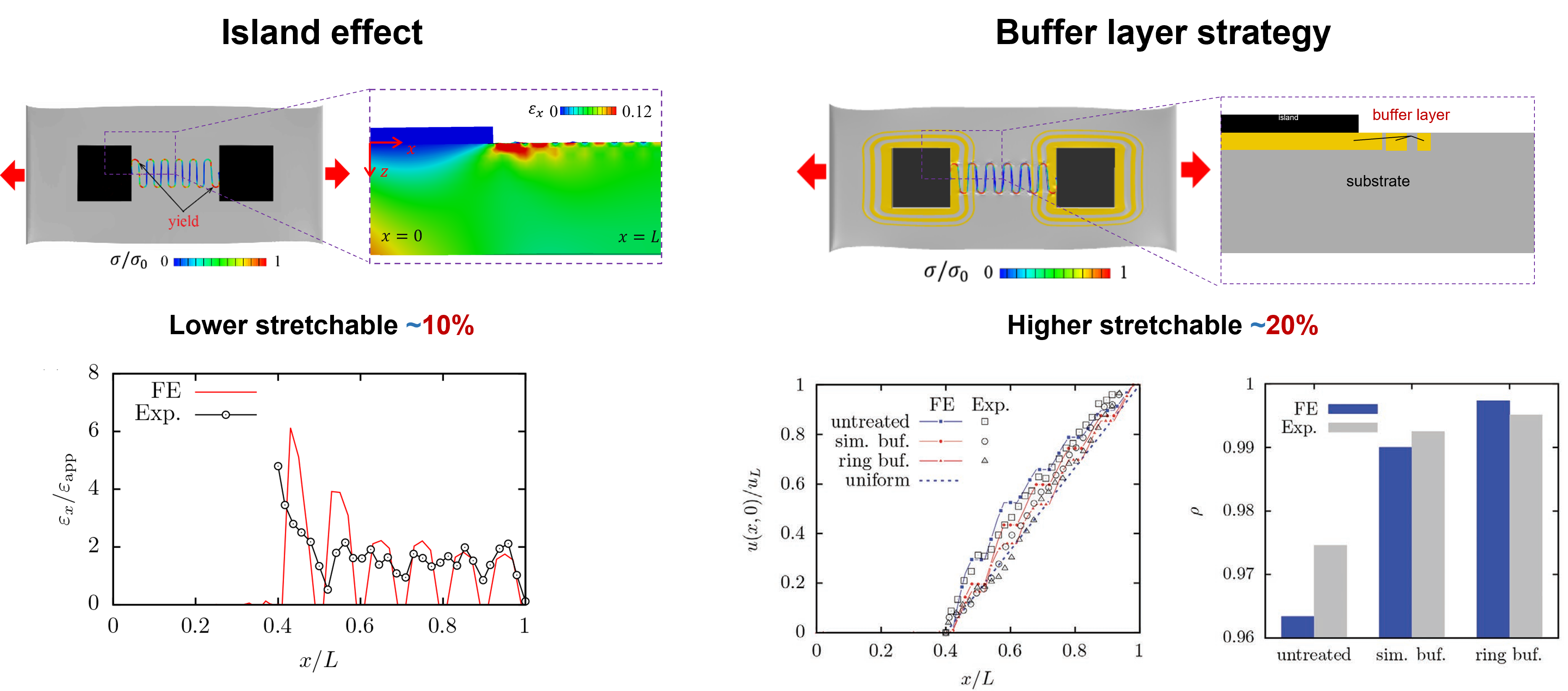
 赞
赞
的个人主页 http://shi.buaa.edu.cn/xuezhaoguo/zh_CN/index.htm
Mechanically guided assembly of 3D structures and electronics
3D microstructure and electronic devices with engineered three-dimensional (3D) architectures are of growing interest, owing to their increasing applications in diverse areas, e.g., biomedical devices, energy storage systems, photonics and optoelectronics, microelectromechanical systems, and metamaterials. The mechanically-guided assembly method based on the controlled compressive buckling has been demonstrated as a robust route to sophisticated 3D functional devices. This method is fully compatible with the conventional microfabrication technologies, and is thereby applicable to a broad set of materials (e.g. metals, semiconductors, and soft polymers) and length scales (e.g. from nanometers to centimeters). Based on this assembly method, we carried out relevant research work.
a) Assembly of complex 3D structures and electronics on curved surfaces
Biological systems, including both plants (e.g., stems, flowers, and seeds) and animals (e.g., hearts, alveolus pulmonis, brains, blood vessels, and tracheas), mostly have complex 3D curved surfaces, some with dynamic, time-varying features. Developments of manufacturing approaches/technologies to allow conformal integration of electronic systems with these 3D surfaces are of utmost importance for high-fidelity information interactions with these biological systems. The resulting 3D conformal electronic systems have widespread applications in health monitoring, human-machine interfaces, curved displays, therapeutic devices, artificial tissues/organs, and fundamental biomedical research. We developed a set of unique assembly strategies and design concepts to allow transformation of 2D thin films into com- plex 3D structures on almost arbitrary 3D curved substrates, including those with regular surfaces (e.g., hemisphere, cylinder, helicoid, spiral, and hyperboloid) and biomimetic surfaces (e.g., twining vines, human face, brain-like surface, aorta, and heart-like surface). The strategy leverages predefined mechanical loadings that deform curved elastomer substrates into flat/cylindrical configurations, followed by an additional uniaxial/biaxial prestretch to drive buckling-guided assembly. Release of predefined loadings results in an ordered assembly that can be accurately captured by mechanics modeling, as illustrated by dozens of complex 3D structures assembled on curved substrates. Demonstrated applications include tunable dipole antennas, flow sensors inside a tube, and integrated electronic systems capable of conformal integration with the heart.

b) Morphable three-dimensional electronic mesofliers capable of on-demand unfolding
Development of miniaturized 3D fliers with integrated functional components has important implications to a diverse range of engineering areas. Among the various active and passive miniaturized 3D fliers reported previously, a class of 3D electronic fliers inspired by wind-dispersed seeds show promising potentials, owing to the lightweight and noiseless features, aside from the stable rotational fall associated with a low falling velocity. While on-demand shape-morphing capabilities are essential for those 3D electronic fliers, the realization of such minia- turized systems remains very challenging, due to the lack of fast-response 3D actuators that can be seamlessly integrated with 3D electronic fliers. We developed a type of morphable 3D mesofliers with shape memory polymer (SMP)-based electrothermal actuators, capable of large degree of actuation deformations, with a fast response (e.g., ~1 s). Integration of functional components, including sensors, controllers, and chip batteries, enables development of intelligent 3D mesoflier systems that can achieve the on-demand unfolding, triggered by the processing of real-time sensed information (e.g., acceleration and humidity data). Such intelligent electronic mesofliers are capable of both the low-air-drag rising and the low-velocity falling, and thereby, can be used to measure the humidity fields in a wide 3D space by simple hand throwing, according to our demonstrations. The developed electronic mesofliers can also be integrated with other types of physical/ chemical sensors for uses in different application scenarios.

Relevant publications:
Science Advances, 2022, 8, eabm6922
Science Advances, 2020, 6, eabb7417
Nature Commun., 2020, 11, 1180
PNAS, 2019, 116, 15368
PNAS, 2021, 118, e2026414118
Advanced Materials, 2021, 33, 2102684
NPG Asia Materials, 2019, 11, 29
National Science Review, 2020,7, 342
Int. J. Smart Nano Mater., 2022, 13, 17
Science China Materials, 2022. 65, 2309
Science Robotics, 2022, 7, eabn0602
Flexible/Stretchable Inorganic Electronics
a) Island Effect in Stretchable Inorganic Electronics
Island-bridge architectures represent a widely used structural design in stretchable inorganic electronics, where deformable interconnects that form the bridge provide system stretchability, and functional components that reside on the islands undergo negligible deformations. These device systems usually experience a common strain concentration phenomenon, i.e., “island effect”, because of the modulus mismatch between the soft elastomer substrate and its on-top rigid components. Such an island effect can significantly raise the surrounding local strain, therefore increasing the risk of material failure for the interconnects in the vicinity of the islands. We carried out a systematic study of such an island effect through combined theoretical analysis, numerical simulations and experimental measurements. To relieve the island effect, we proposed a buffer layer strategy as a generic route to enhanced stretchabilities of deformable interconnects. Both experimental and numerical results illustrate the applicability of this strategy to 2D serpentine and 3D helical interconnects, as evidenced by the increased stretchabilities (e.g., by 1.5 times with a simple buffer layer, and 2 times with a ring buffer layer, both for serpentine interconnects).

Relevant publications:
Science Advances, 2022, 8, eabm3785
Small, 2022, 18, 2107879
Advanced Materials, 2020, 32, 1902254
Morphology Engineering of In-Plane Silicon Nanowires
Silicon nanowires (SiNWs) with controllable morphologies are ideal building blocks to explore various novel nanoelectronic devices, where periodic diameter or orientation self-oscillations provide unique routes to tailor the desired photonic, transport, and mechanical properties targeting at specific optoelectronics, quantum electronics, flexible/stretchable electronics, and bioelectronics applications. In-plane solid-liquid-solid (IPSLS) SiNWs, grown by metal catalyst droplets that absorb hydrogenated amorphous silicon (a-Si:H) thin film to produce crystalline SiNWs, are particularly suitable for planar device fabrication and integration. This unique growth mode, where the strong interfacial force exerted by the front and rear “solid-liquid” interfaces on the soft catalytic droplet, offers great potential to control the rich morphology. By studying the significant interface effects, we developed various strategies to tailor the morphologies engineer of in-plane silicon nanowires, varying from island-chain, to straight and zigzag. In addition, we proposed and demonstrated deterministic line-shape programming of ultralong in-plane SiNWs into extremely stretchable c-Si springs or arbitrary singly connected 2D fractal patterns. This also enabled the robust batch-fabrication of high-performance Fin-TFTs with high hole mobility and an excellent subthreshold swing via a low temperature <350 °C thin film process.

Related publications:
Nature Commun., 2016, 7, 12836;
Adv. Funct. Mater., 2016, 26, 5352
Nano Letters, 2016, 16, 7317
Nano Letters, 2014, 14, 6469
Nano Letters, 2017, 17, 7638
Nanoscale, 2017, 9, 10350
Nanoscale, 2015, 7, 5197
Appl. Surf. Sci., 2022, 593, 153435
Appl. Surf. Sci., 2015, 334, 15
J. Semicond., 2018, 39, 1